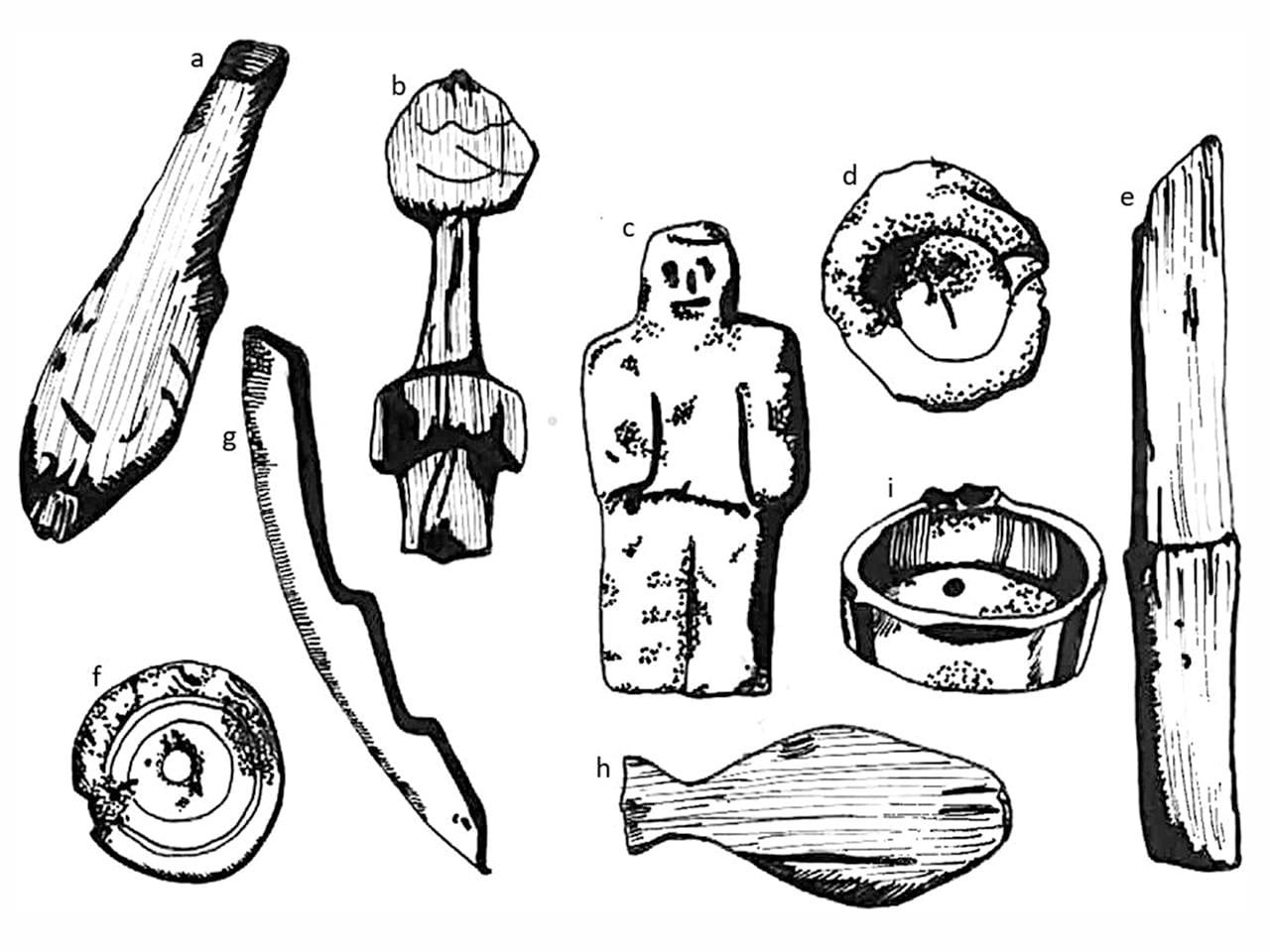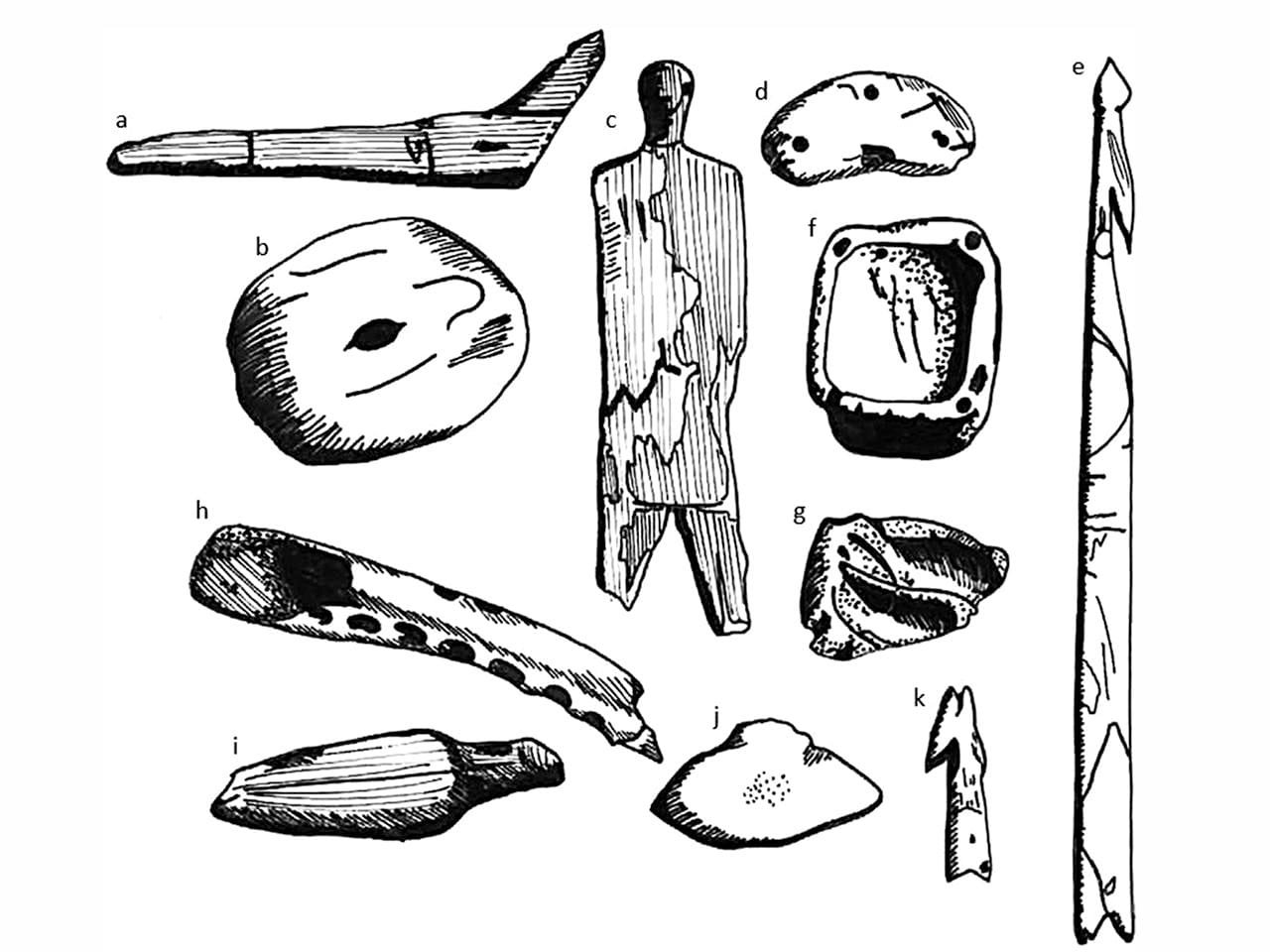A study published in the European Journal of Archaeology by Mathilde Vestergaard Meyer and Dr. Felix Riede examines how children’s toys influenced the adaptability of two cultures, the Norse and the Inuit, during the Little Ice Age in Greenland. This research reveals the unexpected role of childhood play in societal survival under extreme climatic conditions.
 Nordic toys. a: bird figure (wood); b: toy sword (wood); c: doll ( steaтιтe); d: pot (steaтιтe); e: knife (wood); f: spinning top disk (whalebone); g: ship’s bow pole (wood); h: fish figure (wood); i: bowl (steaтιтe). Not to scale. Credit: Meyer MV, Riede F., Journal of Archaeology (2024)
Nordic toys. a: bird figure (wood); b: toy sword (wood); c: doll ( steaтιтe); d: pot (steaтιтe); e: knife (wood); f: spinning top disk (whalebone); g: ship’s bow pole (wood); h: fish figure (wood); i: bowl (steaтιтe). Not to scale. Credit: Meyer MV, Riede F., Journal of Archaeology (2024)
Greenland, one of the world’s largest islands, has a narrow inhabitable strip of land. During the Little Ice Age (ca. 1458–1552 CE), both the Norse settlers, who arrived around CE 986, and the Inuit, who migrated from northern Alaska via Canada during the eleventh century, faced the harsh environmental challenges of colder and drier climates. While the Inuit adapted and thrived, the Norse disappeared. Traditional theories attribute the Norse decline to factors such as overgrazing, reliance on unsustainable agriculture, increased sea ice hindering trade, and violent storms. However, this study introduces a new perspective—children’s toys as a proxy for societal adaptability.
The research team analyzed over 3,000 Inuit toys and 72 Norse toys from archaeological sites. Inuit toys included miniature kayaks, harpoons, knives, and lamps, all designed to teach practical survival skills in a hostile environment. These play objects fostered creativity, experimentation, and autonomy, preparing children for real-world challenges.
In contrast, Norse toys were fewer in number and focused on reinforcing agricultural roles, such as figurines of birds and basic tools. This limited variety reflected a more rigid cultural framework, leaving little room for innovation or adaptation as environmental conditions deteriorated. Dr. Riede explains, “The Inuit’s diverse toy kits not only mirrored their adaptive strategies but actively nurtured innovation among younger generations. The Norse toys, however, reinforced a normative and static way of life.”
 Inuit toys from the collection of the National Museum of Greenland in Nuuk. a: sledge runner and upstander (wood), b: disc for spinning top (wood), c: doll (wood), d: sealing stool (for sitting on when hunting seals on the ice (bone), e: harpoon (baleen), f: cooking pot (soapstone), g: lamp with ledge (soapstone), h: ajagaq (bone), i: snow knife (wood), j: ulo blade (women’s knife; slate), k: harpoon head (bone). Not to scale. Credit: Meyer MV, Riede F., Journal of Archaeology (2024)
Inuit toys from the collection of the National Museum of Greenland in Nuuk. a: sledge runner and upstander (wood), b: disc for spinning top (wood), c: doll (wood), d: sealing stool (for sitting on when hunting seals on the ice (bone), e: harpoon (baleen), f: cooking pot (soapstone), g: lamp with ledge (soapstone), h: ajagaq (bone), i: snow knife (wood), j: ulo blade (women’s knife; slate), k: harpoon head (bone). Not to scale. Credit: Meyer MV, Riede F., Journal of Archaeology (2024)
Categorized into skill play, social play, transport, tools, and weapons, the study revealed significant differences in the diversity and purpose of toys. Meyer notes, “The Inuit toy kits contained a greater percentage of weapons, while Norse toy kits had more tools. More strikingly, the Inuit toy diversity increased over time, particularly during the onset of the Little Ice Age. This may reflect a deliberate cultural adaptation or unconscious responses to environmental pressures.”
The Inuit’s ontogenetic niche, or the developmental environment for children, emphasized autonomy and exploration. These practices allowed children to experiment with new technologies and strategies, such as dog sleds and the umiaq (a large boat), crucial for surviving the harsh conditions. In contrast, the Norse ontogenetic niche adhered to established norms, limiting their capacity to innovate or transition to marine-based economies.
 Inuit play objects. Left: a collection of ajagaqs made from the bones of different animals. Right: spinning top discs made of wood and bone. Credit: Meyer MV, Riede F., Journal of Archaeology (2024)
Inuit play objects. Left: a collection of ajagaqs made from the bones of different animals. Right: spinning top discs made of wood and bone. Credit: Meyer MV, Riede F., Journal of Archaeology (2024)
The study highlights how the material culture of childhood contributes to societal resilience. The diversity in Inuit toys reflects not just their adaptability but also a deliberate pedagogical approach that enabled experimentation and independence. This contrasts starkly with the Norse, whose rigidity is evident in their limited toy ᴀssemblage and inability to fully transition to new subsistence strategies.
“Our data support the idea that the objects filling the cultural niches of these societies had a vital effect on their ability to adapt and survive adverse environmental conditions over multiple generations and centennial timescales,” the researchers conclude.
This research invites reflection on how contemporary societies educate children to face modern challenges, such as climate change and social crises. By fostering creativity and adaptability in childhood, future generations can better navigate uncertainties. The Inuit experience demonstrates how a culture’s approach to childhood can make the difference between survival and decline.
More information: Meyer MV, Riede F. (2024). Playing to Survive: Children and Innovation During the Little Ice Age in Greenland. European Journal of Archaeology:1-20. doi:10.1017/eaa.2024.36





